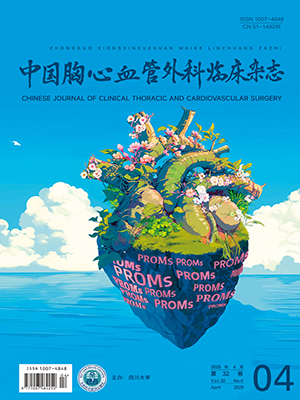| 1. |
陈飞, 王悠清. 1990—2019年中国食管癌疾病负担及其变化趋势分析. 中国肿瘤, 2021, 30(6): 401-407.
|
| 2. |
朱多杰, 李斌, 王成, 等. 术后辅助治疗对局部进展期(pT3N0M0)食管鳞癌远期生存影响的回顾性分析. 中国肿瘤临床, 2018, 45(5): 228-231.
|
| 3. |
Watanabe M, Otake R, Kozuki R, et al. Recent progress in multidisciplinary treatment for patients with esophageal cancer. Surg Today, 2020, 50(1): 12-20.
|
| 4. |
Maas KW, Cuesta MA, van Berge Henegouwen MI, et al. Quality of life and late complications after minimally invasive compared to open esophagectomy: Results of a randomized trial. World J Surg, 2015, 39(8): 1986-1993.
|
| 5. |
Sakamoto T, Fujiogi M, Matsui H, et al. Comparing perioperative mortality and morbidity of minimally invasive esophagectomy versus open esophagectomy for esophageal cancer: A nationwide retrospective analysis. Ann Surg, 2021, 274(2): 324-330.
|
| 6. |
Takeuchi H, Miyata H, Ozawa S, et al. Comparison of short-term outcomes between open and minimally invasive esophagectomy for esophageal cancer using a nationwide database in Japan. Ann Surg Oncol, 2017, 24(7): 1821-1827.
|
| 7. |
易俊, 熊磊, 李德闽, 等. 达芬奇机器人在食管癌外科治疗中的应用. 中国胸心血管外科临床杂志, 2015, 22(10): 910-913.
|
| 8. |
Tagkalos E, Goense L, Hoppe-Lotichius M, et al. Robot-assisted minimally invasive esophagectomy (RAMIE) compared to conventional minimally invasive esophagectomy (MIE) for esophageal cancer: A propensity-matched analysis. Dis Esophagus, 2020, 33(4): doz060.
|
| 9. |
徐志华, 张含露, 杨梅, 等. 达芬奇机器人与胸腹腔镜联合辅助McKeown食管癌根治术后患者短期疼痛的非随机对照研究. 中国胸心血管外科临床杂志, 2018, 25(5): 378-381.
|
| 10. |
刘继辉, 孙明, 余兵. 纵隔负压引流管在经右胸途径食管癌手术中的应用. 临床外科杂志, 2021, 29(8): 714-716.
|
| 11. |
孙志勇, 曹子昂, 叶清, 等. 术前运用NRS2002评估食管癌患者营养风险及临床结局的研究. 中国胸心血管外科临床杂志, 2015, 22(4): 323-326.
|
| 12. |
许淑华, 何祺煜, 王小军, 等. 胸腔镜食管癌术后常见并发症的比较分析. 东南大学学报 (医学版), 2021, 40(1): 74-77.
|
| 13. |
Sziklavari Z, Neu R, Hofmann HS, et al. Persistent pleural effusion following thoracic surgery. Chirurg, 2015, 86(5): 432-436.
|
| 14. |
Xu Y, Li XK, Cong ZZ, et al. Long-term outcomes of robotic-assisted versus thoraco-laparoscopic McKeown esophagectomy for esophageal cancer: A propensity score-matched study. Dis Esophagus, 2021, 34(9): doaa114.
|
| 15. |
Nakahara Y, Yamasaki M, Miyazaki Y, et al. Reflux after esophagectomy with gastric conduit reconstruction in the posterior mediastinum for esophageal cancer: Original questionnaire and EORTC QLQ-C30 survey. Dis Esophagus, 2018, 31(7): 1-7.
|
| 16. |
Quiding H, Häggquist SO. Visual analogue scale and the analysis of analgesic action. Eur J Clin Pharmacol, 1983, 24(4): 475-478.
|
| 17. |
Bray F, Ferlay J, Soerjomataram I, et al. Global cancer statistics 2018: GLOBOCAN estimates of incidence and mortality worldwide for 36 cancers in 185 countries. CA Cancer J Clin, 2018, 68(6): 394-424.
|
| 18. |
纪晨光, 刘丽, 冯志杰. 早期食管癌的内镜下诊治进展. 河北医科大学学报, 2021, 42(6): 735-739.
|
| 19. |
侯广杰, 连戈, 郭宝峰, 等. 胸腹腔镜联合切除局部晚期食管癌手术视频要点. 中国胸心血管外科临床杂志, 2020, 27(6): 627-628.
|
| 20. |
Sihag S, Ku GY, Tan KS, et al. Safety and feasibility of esophagectomy following combined immunotherapy and chemoradiotherapy for esophageal cancer. J Thorac Cardiovasc Surg, 2021, 161(3): 836-843.
|
| 21. |
徐杨, 申翼. 达芬奇机器人在食管外科中的应用. 医学研究生学报, 2021, 34(1): 1-7.
|
| 22. |
范富翠, 童雅萍, 梁冠冕, 等. NRS2002结合营养指标评价食管癌术后出院患者的营养状况. 广东医学, 2020, 41(19): 1970-1974.
|
| 23. |
赵澜涛, 王亮, 陈建海, 等. 经纵隔右胸腔引流管在食管癌根治术后引流效果分析. 山西医药杂志, 2020, 49(4): 447-449.
|
| 24. |
Marshall K, McLaughlin K. Pain management in thoracic surgery. Thorac Surg Clin, 2020, 30(3): 339-346.
|
| 25. |
Ashok A, Niyogi D, Ranganathan P, et al. The enhanced recovery after surgery (ERAS) protocol to promote recovery following esophageal cancer resection. Surg Today, 2020, 50(4): 323-334.
|
| 26. |
Rubinkiewicz M, Witowski J, Su M, et al. Enhanced recovery after surgery (ERAS) programs for esophagectomy. J Thorac Dis, 2019, 11(Suppl 5): S685-S691.
|





 Baidu Scholar
Baidu Scholar